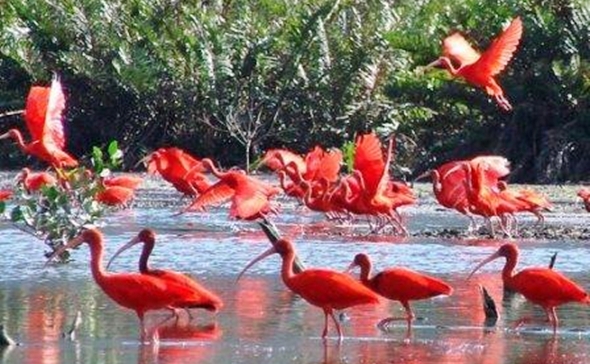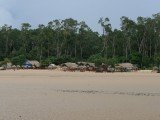Este post também está disponível em:
Português
English
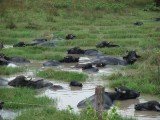
The Marajó Archipelago is located at the mouth of the Amazon River in the state of Pará, bordering the Amazon and the Atlantic Ocean.
It is made up of approximately 3,000 islands, with emphasis on Marajó Island, its largest island, with 49,602 m².
Marajó Island enchants its visitors for the diversity of its fauna and flora, spread over 12 municipalities.
It is considered the largest river-maritime island in the world, surpassing the area of Belgium or the Netherlands. It has beautiful beaches with calm waters, with a great variety of birds and fish. It is the land of açaí, of hot rhythms such as carimbó and lundu, and of Marajoara pottery.
The east side of the island is a savannah-covered plain.
The west side has dense forests. Surrounded by the Atlantic Ocean and the Amazon and Pará rivers, Marajó Island is also the stage for “pororoca” – the phenomenon of giant waves forming at the meeting of river and sea waters.
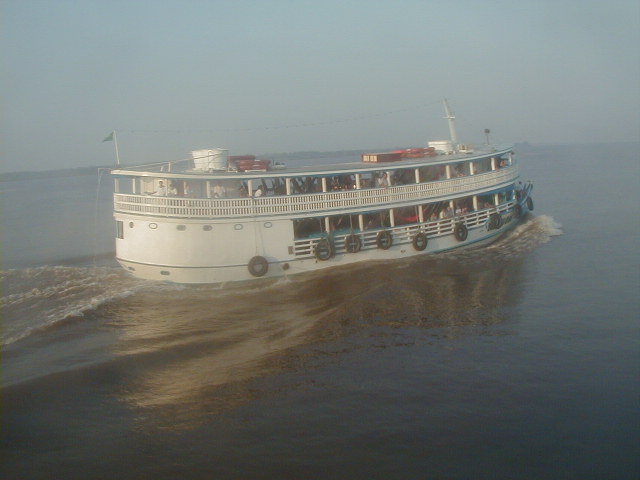
During the period of intense rainfall – between January and May – part of Marajó’s territory is flooded. This provides optimal conditions for buffalo breeding and makes the island home to the largest herd in Brazil.
These animals are commonly used for transportation – both in the countryside and in cities – and their meat is the basis of some of the region’s typical dishes.
Marajoara culture
Marajoara culture is also present in folkloric dance performances, such as carimbó and lundu.
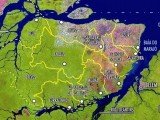
Ceramics is another great attraction offered by the Island and can be seen at the Marajó Museum, in Cachoeira do Arari, 74 km from Soure.
Local craft stores also offer examples of this art for purchase.
A good option to get to know the culture, fauna and flora of the region is to stay in one of the farms adapted to accommodate tourists.
There, the visitor can take trips in jeeps, boats or on horseback, get to know the streams, wetlands, pastures and forests. The cities of Soure and Salvaterra are the most visited by tourists.
History of Marajó Island
Around the year 400 after Christ, hierarchical and regional societies emerged on Marajó Island.
Under the rule of the chiefs, the new form of social organization was legitimized by rituals, during which the shamans bridged the gap between the earthly world and that of the spirits and ancestors.
Symbols and images often conceived during hallucinogenic trances passed through this bridge. Marajoara art was born.
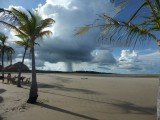
The collective imagination became visual in the form of drawings that remind us of labyrinths, spirals, triangles, circles, rectangles, tridents and
faces.
With themes closely related to the local fauna, the ceramic designs constituted an iconographic language, where mythical beings were represented in a logical, coherent and harmonious way, regardless of techniques, shapes and surfaces.
The collective experience legitimized an art that was born from the need to visualize and communicate emotions, feelings, truths, tradition, social positions, history. As in any society that does not know writing, such art would have the function of storing and socializing knowledge.
How to get to the island of Marajó
.
By River: leaving from Belém, capital of the State of Pará, there are boats that depart from Avenida Marechal Hermes Galpão 15 – Companhia das Docas do Pará – CDP. The trip takes approximately 3 hours.
Those going by car should take the ferry that departs from Rua Siqueira Mendes, s/n (1st Street) Icoroaci, 13 km from Belém. Another departure point for tourists arriving there by boat is Salvaterra, which is 83 km away as the crow flies, four hours by boat from Belém.
By Air: There is the option of flights by air cab companies. Travel agencies in Belém organize complete packages to Marajó Island.
What to do Marajó Island
.
In Marajó there is no hurry. Tranquillity dictates the rhythm of the day-to-day life of the land. Land, in fact, populated with stories of an ancient people. Where the struggles, victories, defeats and language can be known in a visit to the Museum of Marajó, in the city of Cachoeira do Arari.
There, the nuances of the people of Marajó are translated into pieces and fragments exposed.
The museum also houses the Piranha House – a place for the preservation of the species.
The visitor can also have contact with the reality of the residents of Marajó, tasting the traditional “cheese of Marajó” or simply being enchanted by the rhythm of folk dances and beauties of Marajoara handicrafts, rich in details and symbologies.
But if the purpose is to get to know the island in a peculiar way, just go to one of the farms that exist in the place and choose the mount. The buffalo or the Marajoara horse are ideal for discovering the vast expanses of the place.
There are also ecological trails and boat trips.
The beaches complete the Marajó scenery. Pesqueiro, Araruna and Barra Velha are close to the center of Soure.
In Salvaterra, there are the beaches of Joanes, Monsarás and Grande. Most of them have white sand, small dunes and blue water. On the busiest beaches, there are rustic tents serving drinks and snacks.
For those looking for extreme sports, Marajó is also a great option.
At high tide, rafting, where you go down the rivers aboard a boat, is one of those unmissable thrills.
For those who like a more peaceful ride, the tip is to take advantage of the low tide and ride a bicycle along the coast of the beautiful beaches of Pesqueiro (Soure) and Pescadores (Salvaterra).
Marajó is also home to one of nature’s most exciting phenomena: the pororoca. This is the name given to the encounter between the waters of the Amazon River and the Atlantic Ocean, which takes place from May to July.
The best place to observe it is Caviana Island, with five thousand square meters.
Festivals on the Island of Marajó
Festival of Quadrilhas and Boi-Bumbá – SOURE E SALVATERRA
Both take place annually in the second half of June.
Festa de Nossa Senhora de Nazaré – SOURE
It takes place in November and enchants everyone with the mixture of colors and the contagious joy of the local population.
Attractions in the Island of Marajó
Fields
Dry in summer and flooded in winter, the Marajo fields have a characteristic native vegetation with a rich fauna.
The landscape changes with each season: in January, green awakens, covering the ground; from the middle of the year onwards, the soil appears cracked, with a lacustrine tone.
But rain or shine, it’s easy to spot the local birds. Among them are guarás, grebes, herons and jaburus. It is also common to see pacas, agoutis and caimans.
Due to the immense farms scattered throughout the island, the presence of the buffalo is striking, which has made it a symbol of Marajó.
Not all farms are accessible by road. Many, especially during the flood season, can only be accessed by boat or plane.
Forests
The forests of the region are very rich in fruits and food, which guarantees the presence of animals. Among the trees, açaizais are easily found. As the vegetation is mostly soaked in water, human interference is hampered, which keeps the forest preserved.
Beaches
The coastline of Marajó is deserted and wild, full of beaches and small river arms, the igarapés.
The sea is responsible for the transformation that occurs in the landscape. There are six months of fresh water – the region’s winter – when the muddy waters of the Amazon River invade the rivers and seas, influencing the beaches.
And six months of salt water, due to the force of the Atlantic, which penetrates the rivers. The main beaches of Marajó are: Praia Sul, Joanes and Monsarás – in Salvaterra; and Praia Norte, Barra Velha, do Araruna and do Pesqueiro – in Soure.
Praia do Pesqueiro (Soure)
This beach, 3 km long, is one of the best known. Its sand is beaten and yellow, with dune formation and lots of shade from coconut trees.
Praia do Araruna (Soure)
To get to this beach you have to cross the Araruna River. Its great attraction is the mangroves that the sea waters have taken over.
Praia Grande (Salvaterra)
All surrounded by coconut trees, Praia Grande is only 1.5 km long. It is possible to visit the lighthouse that is located on the beach.
Praia de Joanes e Monsarás (Salvaterra)
Located 15 km from Salvaterra, Joanes beach is very popular due to the presence of ruins from the 18th century. It has a total length of 2 km.
Other attractions
Fazenda Bom Jesus (Soure)
In this farm, there is a great variety of birds. In addition, the tourist can ride a buffalo and also on horseback.
Fazenda São Jerónimo (Soure)
It offers trails through mangroves, horseback riding and bathing in the igarapés and on the beach.
Fazenda Sanjo (Soure)
It offers bird watching and wild animals, ecological trail, horseback riding, buffalo and canoe rides, alligator spotting and piranha fishing.
Fazenda Camburupy (Soure)
Marajoara horseback riding, day-to-day tradition of the Marajoara cowboy.
Marajoara ceramics
One of the strengths of Marajó Island is its pottery. The oldest examples of Marajoara pottery are said to date from 980 BC and the most recent originals date from the 18th century.
The ceramic objects were discovered in archaeological excavations and are the only relics of the Marajoara people – who dominated the region until the 14th century.
The most representative are the vases and jars decorated with drawings of animals or parts of the human body and funerary urns, in which the leaders of the tribe were buried. It is possible to get to know this art at the Marajó Museum – already awarded by the National Historical and Artistic Heritage Institute (IPHAN) -, and at the Emílio Goeldi Museum. Visit:
Shopping
Marajoara ceramic replicas
Arte em Barro – Tr. 20, between 3rd and 4th streets. Open from 8am to 7pm
Sociedade Marajoara das Artes – 3rd street (between travessas 18 and 19), open Monday to Saturday, from 8am to 12pm and from 2pm to 6pm; on Sundays, from 8am to 12pm.
Leather goods
Bovine and buffalo (sandals, boots and bags): Curtume Marajó – 1st street, 450 (B. Novo), open from 7am to 7pm.
Marajó Archipelago Tourism and Travel Guide
